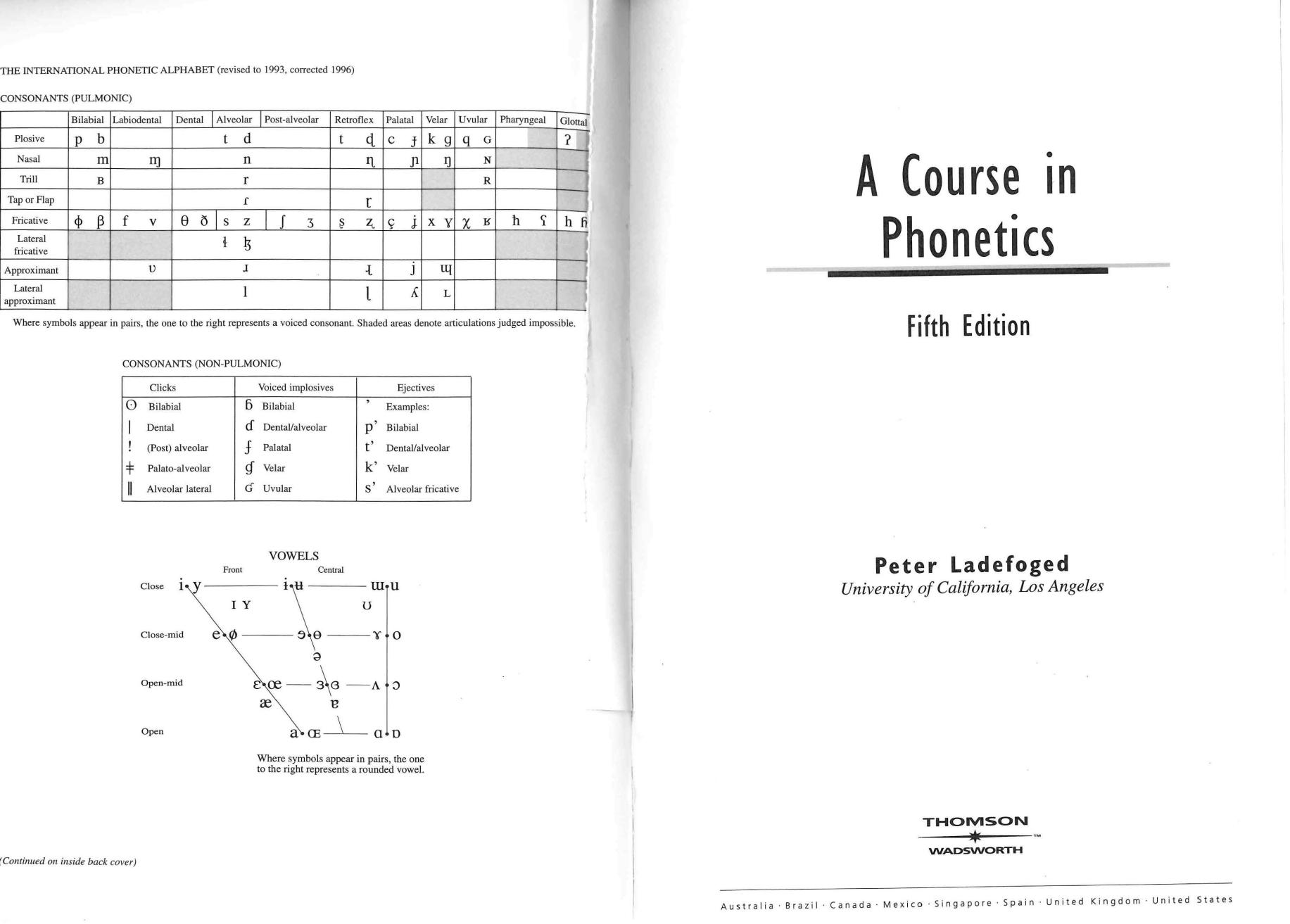A Course in Phonetics by Peter Ladefoged

Author:Peter Ladefoged
Language: eng
Format: mobi, pdf
Tags: Linguistics, Non fiction
Published: 2012-12-07T00:41:45+00:00
Articulatory Targets 165
TABLE 7.1 Contrasting bilabial and labiodental fricatives in Ewe.
Voiceless bilabial fricative
e!Fa!
e!Fle~
‘he polished’
‘he bought’
Voiceless labiodental fricative
e!Fa!
e!fle!‡
‘he was cold’
‘he spit off’
Voiced bilabial fricative
”~B”~
e!Blo!
CD 7.1
‘Ewe’ (the language)
‘mushroom’
Voiced labiodental fricative
”~v”~
e!vlo!
‘two’
‘he is evil’
(2) Many languages are like English in having the labiodental fricatives [ f, v ].
But probably no language has labiodental stops or nasals except as allophones
of the corresponding bilabial sounds. In English, a labiodental nasal, [ M ], may
CD 7.2
occur when / m / occurs before / f /, as in emphasis or symphony. Say these words in a normal conversational style and see if your lower lip ever contacts your u pper lip during the nasal.
Some languages have affricates in which the bilabial stop is released into a
labiodental fricative. Practice these sounds by learning to say the German words
Pfanne [ "pfanE ] “bowl” and Pflug [ pfluk ] “plough.”
(3) Most speakers of both British and American English have dental fricatives [ T, D ] but no dental stops, nasals, or laterals except allophonically before
[ T, D ], as in eighth, tenth, wealth [ eIt 1T, tEn1T, wEl 1T ]. Many speakers of French, Italian, and other languages typically have dental stops, nasals, and laterals. In these languages, [ t1, d1, n1 ] are not just coarticulated allophones that occur only before [ T, D ], as in English. However, there is a great deal of individual variation in the pronunciation of these consonants in all these languages. According to a careful palatographic study, around one-third of Californian English speakers
have dental stops, and many French speakers have alveolar rather than dental
consonants—well over half of them in the case of the lateral / l /. Say words such
as tip, dip, nip, lip and try to feel where your tongue touches the roof of your mouth.
Some languages, such as Malayalam, a Dravidian language spoken in southern India, contrast dental and alveolar consonants. Examples of contrasting
Malayalam nasals are shown in Table 7.2. The table also includes other consonantal gestures that are used in Malayalam but not in most forms of English. We
will discuss these in subsequent paragraphs.
(4) Alveolar stops, nasals, and fricatives all occur in English and in many
other languages. They need no further comment here.
(5) Retroflex stops, nasals, and fricatives do not occur in most forms of
English. The outstanding exception is the English spoken in India. Retroflex sounds are made by curling the tip of the tongue up and back so that the
Copyright 2010 Cengage Learning, Inc. All Rights Reserved. May not be copied, scanned, or duplicated, in whole or in part.
31269_07_Ch07_pp163-186 pp2.indd 165
11/10/09 3:00:53 PM
Download
This site does not store any files on its server. We only index and link to content provided by other sites. Please contact the content providers to delete copyright contents if any and email us, we'll remove relevant links or contents immediately.
Cecilia; Or, Memoirs of an Heiress — Volume 1 by Fanny Burney(32487)
Cecilia; Or, Memoirs of an Heiress — Volume 2 by Fanny Burney(31906)
Cecilia; Or, Memoirs of an Heiress — Volume 3 by Fanny Burney(31884)
The Lost Art of Listening by Michael P. Nichols(7448)
Asking the Right Questions: A Guide to Critical Thinking by M. Neil Browne & Stuart M. Keeley(5704)
We Need to Talk by Celeste Headlee(5568)
On Writing A Memoir of the Craft by Stephen King(4889)
Dialogue by Robert McKee(4350)
Pre-Suasion: A Revolutionary Way to Influence and Persuade by Robert Cialdini(4181)
I Have Something to Say: Mastering the Art of Public Speaking in an Age of Disconnection by John Bowe(3856)
Elements of Style 2017 by Richard De A'Morelli(3321)
The Book of Human Emotions by Tiffany Watt Smith(3262)
Fluent Forever: How to Learn Any Language Fast and Never Forget It by Gabriel Wyner(3050)
Name Book, The: Over 10,000 Names--Their Meanings, Origins, and Spiritual Significance by Astoria Dorothy(2957)
Good Humor, Bad Taste: A Sociology of the Joke by Kuipers Giselinde(2920)
Why I Write by George Orwell(2909)
The Art Of Deception by Kevin Mitnick(2764)
The Grammaring Guide to English Grammar with Exercises by Péter Simon(2723)
Ancient Worlds by Michael Scott(2645)
